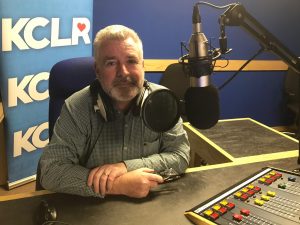Digging deep for Castlecomer doc

This article was first published in the Spring-Summer edition of Fórsa magazine (Issue no.6), which is now circulating in workplaces and which you can download HERE.
NIALL SHANAHAN had a chat with Martin Bridgeman of Fórsa‘s Retired Members vocational group about a new radio documentary he’s made about the Castlecomer coalmine.
Since his retirement from the HSE Martin Bridgeman has continued to devote time and energy to his love of local radio, as well as playing an active part in Fórsa’s Retired Members’ vocational group.
As presenter of Ceol Anocht on Tuesdays and Thursdays (10pm to midnight), on KCLRfm Martin curates an eclectic mix of quality music, providing a platform for Irish musicians.
“With local radio you’ve got to be able to turn your hand to anything” Martin tells me. That means anything from news to long-form interviews and, more recently, producing the station’s Glanbia-sponsored Farm Show.
The first of a five-part documentary about the coal mining history of Castlecomer, which is supported by the Broadcasting Authority of Ireland, was broadcast on the station on 13th April. Martin researched, produced, edited and presented the radio documentary, as the story of Castecomer’s unique mining history intrigued him.
“It’s called Three Miles Over and Three Miles Down, which references the distance some of the miners had to travel to the Deerpark Colliery mine and the journey underground to the coalface. Mining started there in the 1640s.
“At its peak there were around two thousand people involved with the mining industry in that part of north Kilkenny,” he explains.
History
The Castlecomer mine closed in 1969, displaced mainly by the switch to diesel. Martin’s documentary series reaches back to pre-history and the formation of the coalfield, and brings the story up to the present day, and the commercial revival of Castlecomer.
“There was a huge geological interest in the fossils that were found in Castlecomer as these provided a quality comparison for subsequent discoveries, and were used by Charles Darwin’s team to help prove his theory of evolution,” he explains.
At its peak there were around two thousand people involved with the mining industry in that part of north Kilkenny.
Conditions in the coal mines were very difficult. Low pay, poor housing and a lack of washing facilities were key concerns. In the 1920s, Nixie Boran and some of the local miners formed a branch of the Revolutionary Workers’ Group.
Following a visit to the Soviet Union, Boran returned to Castlecomer to help form Castlecomer Workers’ Union, later renamed as The Irish Mine and Quarry Workers’ Union.
They sought to improve pay and working conditions for the miners but faced opposition from the mine owners and local people, including the clergy, because of its supposed communist connections.
Martin says the union was well organised and very active. “The story of their clash with the local clergy is the focus of the fourth episode.
“We also talk to the women of the community, daughters and wives of the mine workers, who themselves seemed rarely to speak of the experience of the mines.
“We look at the struggle for compensation for silicosis or ‘miner’s lung’ which many of the miners fell victim to also,” he says.
The documentary also looks at the affect locally of the mining industry’s departure from the area in 1969. “In recent years Castlecomer has thrived as the Discovery Park, a new hotel, and Michelin star restaurant have all contributed to the revival of the town, which is great to witness fifty years after the fact,” says Martin.
The series continues on KCLR and the series will appear as a podcast in due course on kclr96fm.com.
This article was first published in the Spring-Summer edition of Fórsa magazine (Issue no.6), which is now circulating in workplaces and which you can download HERE.
